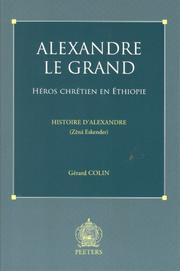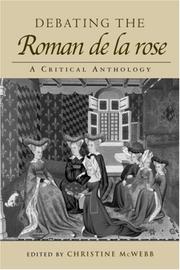| Listing 1 - 4 of 4 |
Sort by
|
Book
ISSN: 11504129 ISBN: 9782251339498 2251339493 Year: 2007 Volume: 49 Publisher: Paris : Belles lettres,
Abstract | Keywords | Export | Availability | Bookmark
 Loading...
Loading...Choose an application
- Reference Manager
- EndNote
- RefWorks (Direct export to RefWorks)
Romances, Byzantine --- Roman courtois byzantin --- Byzantine romances --- Romances, Greek --- Byzantine literature

ISBN: 9789042918900 9782877239660 904291890X 2877239667 Year: 2007 Publisher: Leuven: Peeters,
Abstract | Keywords | Export | Availability | Bookmark
 Loading...
Loading...Choose an application
- Reference Manager
- EndNote
- RefWorks (Direct export to RefWorks)
Alexander III [King of Macedonia] --- Ethiopia --- Romances, Ethiopic --- Roman courtois guèze --- Translations into French. --- Traductions françaises --- Alexander, --- Romances. --- Roman courtois guèze --- Traductions françaises --- Alexander the Great --- Romances --- Romances, Ethiopic - Translations into French --- Alexandre le Grand --- Alexander, - the Great, - 356-323 B.C. - Romances --- Alexander, - the Great, - 356-323 B.C.

ISBN: 0415967651 9780415967655 9780203944608 9781135885878 9781135885823 9781135885861 9780415808927 0415808928 Year: 2007 Publisher: New York: Routledge,
Abstract | Keywords | Export | Availability | Bookmark
 Loading...
Loading...Choose an application
- Reference Manager
- EndNote
- RefWorks (Direct export to RefWorks)
Jean de Meun --- Guillaume de Lorris --- Romances --- Roman courtois --- History and criticism. --- Histoire et critique --- Jean, --- Guillaume, --- History and criticism --- Chivalric romances --- Chivalry --- Courtly romances --- French romances --- Medieval romances --- Romances, French --- Romans courtois --- French literature --- Literature, Medieval --- Romances - History and criticism --- Jean, - de Meun, - d. 1305? - Roman de la rose --- Guillaume, - de Lorris, - fl. 1230. - Roman de la Rose
Book
ISBN: 9781580441230 9781580441247 1580441238 1580441246 Year: 2007 Volume: 48 Publisher: Kalamazoo Medieval Institute publications
Abstract | Keywords | Export | Availability | Bookmark
 Loading...
Loading...Choose an application
- Reference Manager
- EndNote
- RefWorks (Direct export to RefWorks)
“In the earliest versions [of the Loathly Lady tales], the Irish sovereignty hag tales, her excessive body allegorizes the nature of sovereignty; the Loathly Lady is the shape of success in power contestation. Because the vehicle of the allegory is gendered, however, and because the motif’s fictional flesh is sexually active, these ideas about control are entangled with personal power politics. These factors make the motif curiously promiscuous, an intersection of ideas that generates other ideas, sometimes unexpectedly, always provocatively. . . . “ This volume concentrates on the medieval English Loathly Lady tales, written a little later than the Irish tales, and developing the motif as a vehicle for social ideology. Geoffrey Chaucer’s “Wife of Bath’s Tale” and John Gower’s “Tale of Florent” are the better known of the English Loathly Lady tales, but “The Wedding of Sir Gawain and Dame Ragnelle,” the balladic versions—the “Marriage of Sir Gawain” and “King Henry” (and even “Thomas of Erceldoune”)—all use shape-shifting female flesh to convey ideas about the nature of women, about heretosexual relations, and about national identity.”—from the Introduction
820 "04/14" --- Engelse literatuur--Middeleeuwen --- 820 "04/14" Engelse literatuur--Middeleeuwen --- English poetry --- Women in literature. --- Metamorphosis in literature. --- Counseling in literature. --- Sovereignty in literature. --- Romances, English --- Ballads, English --- Ballads, English. --- Romances, English. --- Frau --- Mittelenglische Literatur --- Mittelenglisch. --- Motiv (Literatur). --- Frau. --- Metamorphose (Mythologie). --- Lyrik. --- Versdichtung. --- History and criticism --- History and criticism. --- Middle English. --- Motiv --- Mittelenglische Literatur. --- Gower, John, --- Chaucer, Geoffrey, --- Gawain, --- Gawain. --- Gower, John; Confessio amantis. --- Chaucer, Geoffrey; The Canterbury tales. --- Chaucer, Geoffrey --- Romances --- Studies. --- Confessio amantis (Gower, John). --- Wife of Bath's tale (Chaucer, Geoffrey). --- 1100 - 1500. --- England. --- Gauvain (personnage fictif) --- Gower, John (1325?-1408). Confessio amantis --- Chaucer, Geoffrey (1340?-1400). The wife of bath's tale --- Poésie anglaise --- Femmes --- Métamorphose (littérature) --- Souveraineté --- Roman courtois anglais --- Ballades anglaises --- Histoire et critique --- 1100-1500 (moyen anglais) --- Dans la littérature --- Angleterre (GB)
| Listing 1 - 4 of 4 |
Sort by
|

 Search
Search Feedback
Feedback About UniCat
About UniCat  Help
Help News
News